Imagine walking into a gourmet cheese shop. The air is filled with the rich aroma of blue cheese. Your culinary adventure starts here, learning to pair this cheese.
Blue cheese is more than just dairy. It's a bold flavor that needs careful selection. Whether you're a cheese expert or just starting, mastering cheese pairings can boost your cooking skills.
Each type of blue cheese has its own unique taste. From creamy Gorgonzola to robust Roquefort, they all add something special to your meals.
In this guide, we'll share five key tips for cheese pairing. You'll learn how to pick the right accompaniments and create unforgettable taste combinations. These tips will impress even the pickiest eaters.
Table of contents
Ready to discover the secrets of blue cheese? This culinary journey will excite your taste buds and broaden your cooking horizons.
The Rich History and Origins of Blue-Veined Cheeses
Blue cheese has a long and interesting history. It comes from places like France, England, and Italy. There, making Stilton became a true art.
The story of blue cheese started by accident. It happened in cool, damp caves where cheese was stored.
The magic of blue cheese comes from a special mold called Penicillium roqueforti. This mold makes the cheese look blue or green. It also gives it a strong taste.
This mold is added on purpose. It makes the cheese taste better and keeps it safe from bad bacteria.
Traditional Cave Aging Process
The cave aging process is key to making Stilton. Cheese makers pick caves with the right humidity and temperature. This method has been perfected over centuries.
It helps the cheese develop its unique taste and look.
Development of Regional Varieties
- Roquefort: The legendary French blue cheese made from sheep’s milk
- Gorgonzola: An Italian Stilton with two flavor intensities
- Stilton: An English Stilton known for robust, earthy notes
- Danish Blue: A milder variety with balanced flavors
Historical Significance in Gastronomy
Blue cheese has become a true treasure in cooking. In 1845, Antoine Roussel found that cheeses in cellars grew blue mold. This created a new flavor.
This discovery changed cheese-making forever. It made Stilton a gourmet favorite.
"Blue cheese represents more than just a food - it's a testament to culinary tradition and innovation." - Cheese Historians
Today, Stilton is loved all over the world. Each place adds its own twist to this amazing cheese tradition.
Understanding Blue Cheese Production Methods
Blue cheese or (Stilton) production is a fascinating art that turns simple milk into a complex, flavorful treat. It needs precision, skill, and a deep understanding of microbial cultures.
The journey starts with choosing high-quality milk from cows, goats, or sheep. Cheesemakers add cultures like Penicillium roqueforti or Penicillium glaucum. These cultures create the blue veins and unique flavor.
"Great blue cheese is a delicate balance of science and artistry" - Artisan Cheesemaker
Key Steps in Blue Cheese Production
- Select premium milk from trusted sources
- Add specialized mold cultures
- Create controlled environments for aging
- Pierce cheese with precision needles
- Monitor temperature and humidity carefully
The key step is piercing the cheese with needles. This lets oxygen in, helping mold grow. It makes the cheese’s blue-green veins.
| Production Stage | Duration | Key Characteristics |
|---|---|---|
| Milk Preparation | 1-2 hours | Select high-quality milk |
| Culture Addition | 30-60 minutes | Introduce Penicillium cultures |
| Aging Process | 3-5 months | Develop flavor and texture |
Temperature-controlled environments, like caves, are key. The aging process can last weeks to months. This time allows the cheese to develop its unique taste and texture.
Different places add their own magic to Stilton making. From France’s caves to the United States’ creameries, each place gives the cheese its own special touch.
Essential Characteristics of Blue Cheese
Blue cheese is a world of culinary wonder, with unique flavors that excite the taste buds. Knowing what makes Stilton special helps us enjoy these dairy treasures.
Blue cheese flavors are incredibly varied, offering a wide range of tastes. These cheeses come from cow, sheep, or goat milk. They have blue-green veins from Penicillium mold.
Texture Profiles
Blue cheese textures are quite different, leading to unique eating experiences:
- Creamy and smooth (like Gorgonzola dolce)
- Crumbly and dense (such as Stilton)
- Semi-soft and spreadable
- Firm and granular
Flavor Intensity Levels
Blue cheese flavors range from mild to very strong. Several things affect the taste:
- Milk type
- Aging duration
- Specific Penicillium mold strain
- Regional production techniques
"The beauty of blue cheese lies in its complex flavor journey" - Cheese Artisan Magazine
Aroma Characteristics
Every blue cheese has its own scent. From Roquefort’s earthy smell to Gorgonzola’s sharp notes, they offer a sensory journey.
Pro tip: Explore different blue cheese varieties to discover your personal flavor preference!
Wine and Beverage Pairing Fundamentals
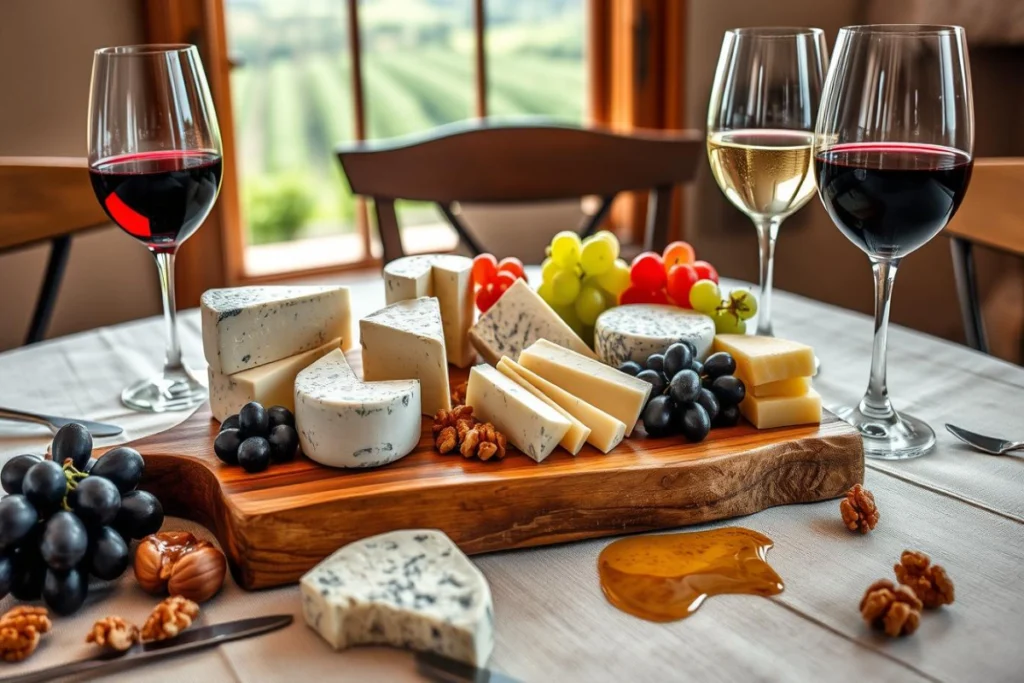
Pairing Stilton with drinks is an art that mixes flavors and drinks. Knowing how Stilton and wine work together can make your meals special. It turns a simple taste into a memorable food adventure.
- Acidic
- Fatty
- Bitter
- Salty
- Sweet
- Alcohol-based
When looking at Stilton pairings, here are some wine choices to consider:
| Blue Cheese Type | Recommended Wine | Flavor Profile |
|---|---|---|
| Mild Blue Cheese (Danish Blue) | Riesling | Sweet with balanced acidity |
| Sharp Blue Cheese (Roquefort) | Vintage Port | Rich, fruity contrast |
| Creamy Blue Cheese (Gorgonzola) | Tawny Port | Nutty, caramel undertones |
Pro tip: Serve cheese at room temperature for the best taste. Take it out of the fridge 30-45 minutes before eating to bring out its flavors.
"The right wine can transform blue cheese from simply delicious to truly extraordinary." - Cheese Pairing Expert
Don’t just stick to wine. Try other drinks that go well with cheese:
Blue Cheese Pairing: A Guide to Perfect Matches
Pairing Stilton is all about finding the right balance. It’s about exploring how flavors mix. Trust your taste and try different things to find your favorite.
Seasonal Accompaniments for Blue Cheese Boards
Making the perfect Stilton board is an art that changes with the seasons. It can turn from a simple platter to a journey of flavors and textures.
To make a memorable cheese board, know how seasonal ingredients match different cheeses. Let’s see how to make your cheese board better all year.
Spring and Summer Blue Cheese Pairings
In warmer months, your cheese board should have light, fresh items. These items balance the cheese’s strong taste. Here are some great pairings:
- Fresh berries like strawberries and raspberries
- Crisp radishes and asparagus spears
- Light honey drizzles
- Delicate herb-infused crackers
Fall and Winter Blue Cheese Combinations
Autumn and winter need richer, more intense Stilton board items. These items warm the palate. Your board might have:
- Caramelized pecans
- Dried cranberries
- Roasted figs
- Aged Gouda with caramel undertones
Year-Round Blue Cheese Board Staples
Some items are great for all seasons on your Stilton board:
| Accompaniment | Flavor Profile | Cheese Compatibility |
|---|---|---|
| Honey | Sweet | Excellent with strong blue cheeses |
| Dried Fruits | Concentrated sweetness | Balances tangy blue cheese |
| Nuts | Earthy, crunchy | Provides textural contrast |
Tip for your Stilton board: Serve cheeses at room temperature. Offer a mix of textures and flavors to keep guests interested.
A well-curated cheese board is not just food—it's an experience that tells a story through flavor.
Regional Blue Cheese Varieties Worldwide
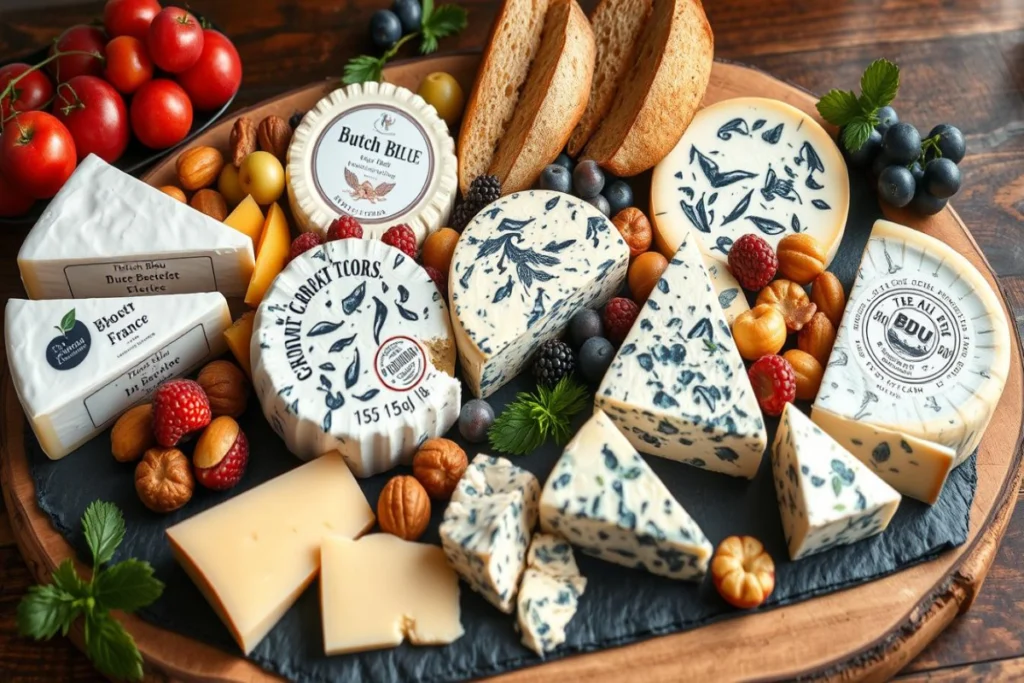
Blue cheese is a journey through different places, each with its own special cheese. From France’s limestone caves to California’s hills, these cheeses show amazing skill. They are made with care and tradition.
Let’s look at some amazing blue cheeses from around the world:
- France: Roquefort, a famous cheese, has been protected since 1925. It’s aged in caves and has blue veins from Penicillium roqueforti mold.
- Italy: Gorgonzola Dolce is creamy, sweet, and nutty. It’s great on bread or toast.
- England: Stilton from Nottinghamshire is a special cheese. Colston Bassett has won many awards.
- United States: Rogue River Blue from Oregon is a World Champion cheese.
"Each blue cheese tells a story of its origin, reflecting centuries of cheese-making expertise." - Artisan Cheese Magazine
Artisanal Stilton making is a detailed process. It turns simple milk into rich, flavorful cheeses. Small producers use special aging methods and local ingredients to make unique cheeses.
| Country | Blue Cheese | Unique Characteristic |
|---|---|---|
| Norway | Nidelven Blå | World’s Best Cheese 2023 |
| Germany | Montagnolo Affine | Supreme Champion at International Awards |
| New Zealand | Kāpiti Kikorangi | Triple Cream Blue Cheese |
Exploring Stilton opens up a world of flavors. Each place adds its own special touch to this beloved cheese. Together, they create a rich tapestry of taste and tradition.
Creating the Perfect Blue Cheese Board
Making a great Stilton board turns a simple event into a special moment. It’s not just about the cheese. It’s about making a beautiful display that pleases the eyes and taste buds.
- Choose 4-5 different cheeses
- Make sure to include at least one cheese
- Offer a mix of textures: hard, soft, and creamy
- Plan for about 3 ounces of cheese per guest
Temperature and Timing
The right temperature is crucial for Stilton . Take your cheeses out of the fridge 30-60 minutes before serving. This lets them warm up and release their full flavor.
Presentation Techniques
Think about how your Stilton board looks. Start by arranging cheeses from mildest to strongest in a circle. Use separate knives for each cheese to avoid mixing flavors.
- Fold salami into fan shapes
- Roll prosciutto elegantly
- Add fresh fruits in season
- Include a variety of crackers and bread
Portion Guidelines
The amount of cheese you serve depends on the event. For appetizers, aim for 2-3 ounces per person. For a main course, go for 5-6 ounces. It’s always better to have a little extra.
"A well-curated blue cheese board is like a delicious work of art—each element carefully chosen to create a harmonious experience."
Culinary Applications and Recipe Ideas
Blue cheese can turn simple dishes into amazing meals. Your kitchen becomes a place for creative Stilton recipes. These recipes add a rich, tangy flavor to everyday ingredients. Whether you cook at home or dream of being a chef, Stilton has endless uses.
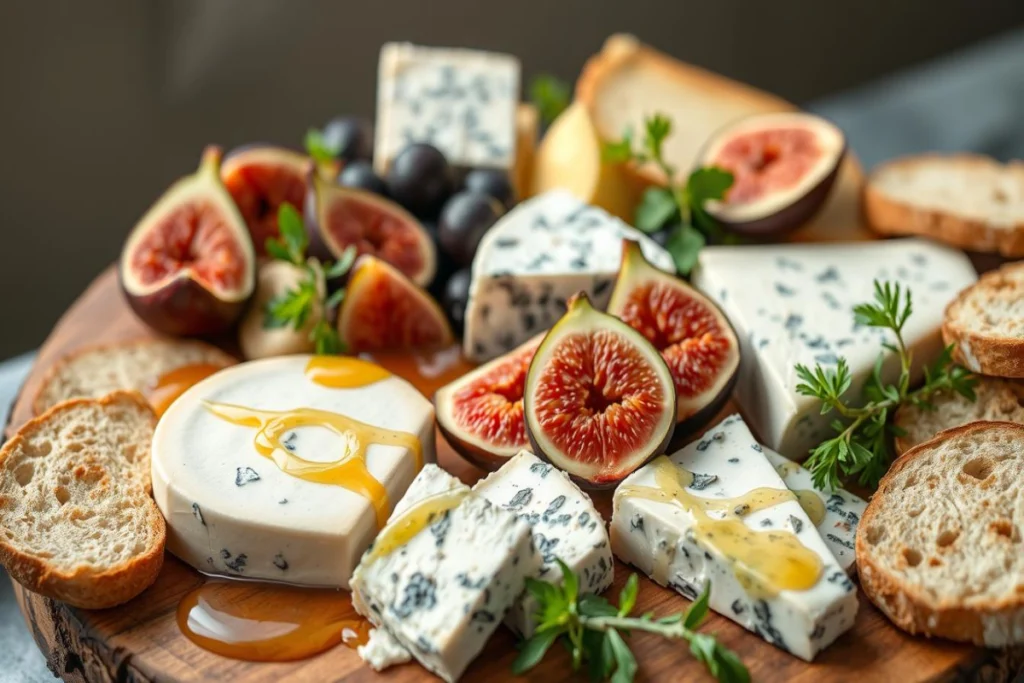
- Salad Enhancement: Sprinkle crumbled Stilton over mixed greens with candied pecans and sliced pears
- Protein Topping: Crumble Stilton on grilled steak for an intense umami boost
- Pasta Transformation: Mix Stilton into creamy pasta with toasted walnuts and a drizzle of honey
- Wing Companion: Create a zesty cheese dressing for chicken wings or vegetable dips
"Blue cheese isn't just a condiment - it's a culinary adventure waiting to happen." - Chef Michael Rodriguez
Blue cheese recipes are not only tasty but also nutritious:
- Average calories per serving: 112-879
- Protein content: 2-52g per serving
- Preparation time: 20-140 minutes
Your cheese dressing can change the game in many recipes. Try different ingredients to make unique flavors that you love.
Health Benefits and Nutritional Profile
Exploring Stilton nutrition facts shows it’s packed with health benefits. It’s not just a tasty addition to meals. It’s also a nutritional powerhouse that boosts your overall health.
Adding Stilton to your diet can bring many benefits. Let’s look at the main nutritional points:
Protein and Calcium Content
Blue cheese is a top source of important nutrients. Here’s what you get from one ounce:
- Approximately 150 mg of calcium per serving
- Around 6 grams of protein
- Support for bone health and muscle development
Probiotic Properties
The fermentation process of Stilton creates probiotic benefits. These beneficial bacteria support digestive health. They help keep your gut microbiome balanced. Regular eating may boost your immune system and digestive health.
Dietary Considerations
Stilton has many health benefits, but eating it in moderation is key. Here are some nutritional facts:
- Contains approximately 100 calories per ounce
- Rich in vitamins A, B12, and phosphorus
- Potential risks for those with dairy sensitivities
"Blue cheese is not just a condiment, but a nutritional ally when consumed mindfully." - Nutritional Expert
Enjoying Stilton should be done in balance. It’s great for your health, but those with dietary restrictions should talk to a doctor first.
Storage and Handling Best Practices
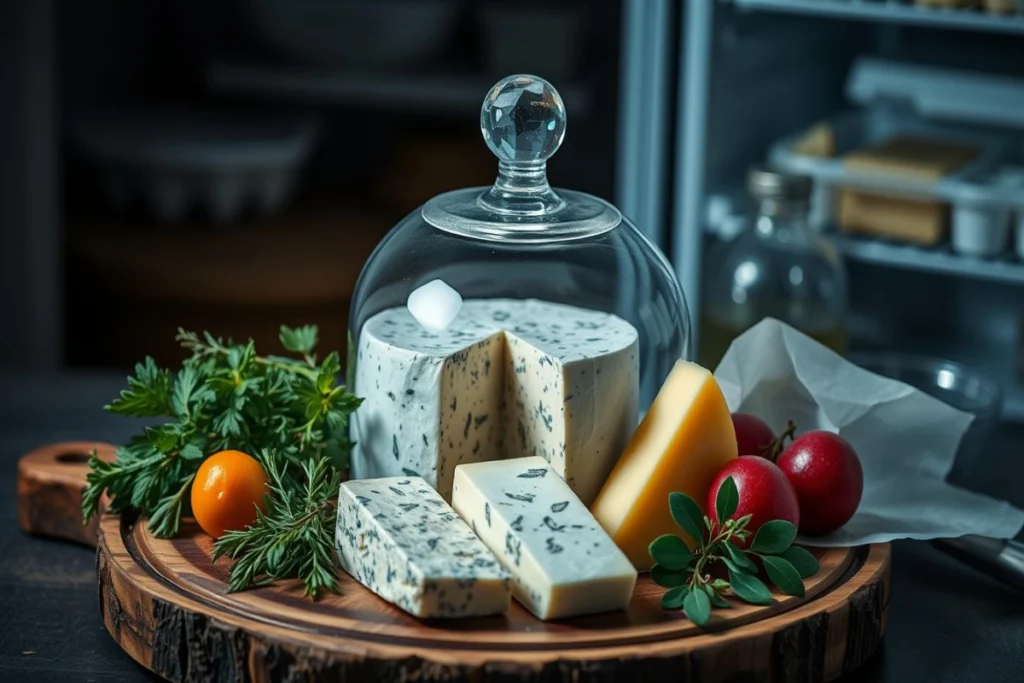
Keeping your blue cheese fresh is key. The way you store it can greatly affect its taste and texture. This makes a big difference in how much you’ll enjoy it.
"Proper storage is the secret to preserving the unique character of blue cheese," say professional cheesemongers.
Knowing how to store Stilton is crucial. It helps keep its special taste and stops it from spoiling too soon. The storage method you choose depends on the type of blue cheese you have.
- Store blue cheese between 35-45°F in the refrigerator’s crisper drawer
- Use specialized cheese paper or parchment for wrapping
- Avoid tight plastic wrap that restricts air circulation
- Rewrap cheese after each use to minimize air exposure
Different blue cheese varieties need slightly different storage methods. Harder cheeses can last longer than softer ones.
| Cheese Type | Recommended Storage | Estimated Shelf Life |
|---|---|---|
| Soft Blue Cheese | Refrigerated, loosely wrapped | 1-2 weeks |
| Hard Blue Cheese | Cool drawer, paper-wrapped | 3-4 weeks |
| Crumbled Blue Cheese | Sealed container | 1 week |
Pro tip for blue cheese storage: Buy only what you’ll eat in a few days. This keeps it fresh and reduces waste.
When you handle Stilton, use clean tools. Try not to touch it too much to avoid contamination. By following these tips, you’ll keep the cheese’s flavor and enjoy it more.
Common Myths and Misconceptions About Blue Cheese
Blue cheese often faces many misunderstandings. These can stop people from trying its unique tastes. Let’s look at some Stilton facts and clear up common myths.
"Not all blue cheese is created equal, and misconceptions can prevent you from enjoying an incredible culinary experience."
Many think blue cheese is just “rotten” or not safe to eat. But, the blue-green veins are made by adding mold cultures on purpose. These cultures, like Penicillium roqueforti, give the cheese its special taste and look.
- Myth: Blue cheese is just moldy cheese
- Fact: Specialized mold cultures are intentionally added during production
- Myth: Blue cheese is always extremely pungent
- Fact: Flavor intensity varies across different blue cheese varieties
Some also believe blue cheese is only good for a few dishes. But, blue cheese facts show it’s very versatile. It can make many dishes better, from salad dressings to gourmet burgers. Start with milder cheeses like Gorgonzola Dolce and then try stronger ones like Roquefort.
Learning about blue cheese can change how you cook. Don’t let myths stop you from enjoying the rich, complex tastes of these cheeses.
Conclusion
Exploring blue cheese is more than just tasting it. From France's Roquefort to Italy's Gorgonzola, there's a world of flavors to discover. With your blue cheese pairing skills, you can make any meal unforgettable.
Blue cheese is also good for you. It's full of Vitamin B5, B2, and selenium. These help lower heart disease risk and fight inflammation. Plus, its unique cultures and low lactose make it great for health-focused eaters.
Blue cheese combines tradition and creativity. It's perfect for making fancy cheese boards or trying new recipes. Learning about its types and pairings can improve your cooking and let you enjoy its rich history.
As you explore blue cheese, you'll learn about each type's story. It's not just about taste; it's about exploring a world of culture and culinary art.
FAQ
What is blue cheese and how is it made?
Blue cheese is made by adding mold cultures to milk from cows, goats, or sheep. The milk is then pierced to let air in. This creates blue-green veins during aging in controlled environments.
What are some popular types of blue cheese?
Famous blue cheeses include Roquefort from France, Gorgonzola from Italy, and Stilton from England. Each has its own taste and texture, showing the region's influence.
How should I store blue cheese?
Keep blue cheese in the fridge at 35-45°F. Use cheese paper or parchment, then foil loosely. Don't use tight plastic to avoid sweating. Hard cheeses can be frozen, but soft ones don't freeze well.
What are the best pairings for blue cheese?
Pair blue cheese with white wines for fresh cheeses, red wines for aged ones, and beers like wheat ales or stouts. It's great with honey, dried fruits, nuts, in salads, dressings, and with steaks or pasta.
Is blue cheese healthy?
Blue cheese is rich in calcium, protein, vitamins B2 and D, and probiotics. It's high in fat and sodium, so eat it in moderation, especially if you have dietary restrictions.
Can people with lactose intolerance eat blue cheese?
People with mild lactose intolerance might find aged blue cheese easier to digest. The aging process lowers lactose. But, tolerance varies, so talk to a doctor and start with small amounts.
How do I choose a good blue cheese?
Choose blue cheese with consistent veining, moist texture, and a strong aroma. Start with milder cheeses like Gorgonzola Dolce, then try stronger ones like Roquefort.
What is the difference between blue cheese and other moldy cheeses?
Blue cheese uses safe, edible molds to create its flavor and look. These molds are controlled during making, making the cheese safe to eat and unique in taste.
A Note from the Chef
Let us know if you try it, your feedback fuels our passion!


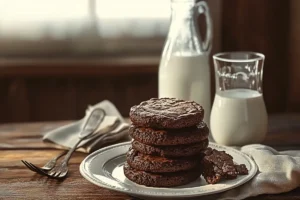

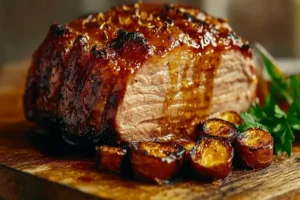
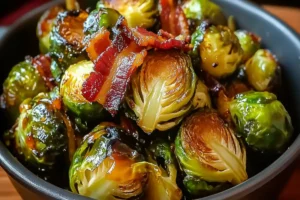

1 thought on “Blue Cheese: 5 Tips for Perfect Pairings”